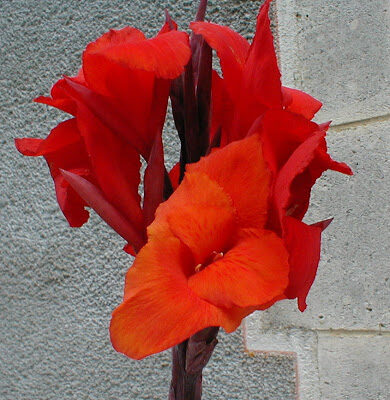Each cell of a canna plant naturally has 18 chromosomes, or 9 pairs of chromosomes from the seed and pollen parents respectively. These plants with their paired chromosomes are termed diploid, from the Greek word for “double”.
How cells are formed

Chromosome Terms
Sometimes, however, the process of meiosis fails, and pollen or ovules are produced that have the full complement of parental chromosomes; this type of cell is called a non-reduced gamete. When such a reproductive cell participates in fertilisation with a haploid cell, an event that does not occur as easily as normal fertilisation, the resulting offspring has three sets of chromosomes instead of the normal two and is termed triploid.
When both pollen cell and ovule cell have the diploid chromosome number, the offspring has four sets and is termed tetraploid. All organisms with more than the normal number of chromosomes are collectively called polyploid.
Polyploid cannas tend to be larger, stronger, more substantial, and more persistent in every respect. This has obvious advantages in any growing context.
The offspring of a triploid and a diploid parent is a tetraploid. Such a cross usually produces few or no normal seeds. With their 27 chromosomes, diploid cannas are difficult to cross with other cannas.
Although in other plants it has been possible to create cultivars with a higher chromosome level, the tetraploid seems to be the limit of the Canna, even after extensive laboratory experiments. Tetraploids can occur naturally as the resulting failure of meiosis, as described for triploids, if there are irregularities in the formation of both parent’s reproductive cells. They can also be produced vegetatively under laboratory conditions.
Fertility
Fertility in Cannas is affected by the chromosome number, and the following table and comments were published by Dr Khoshoo following his research in India in the early 1960’s.
Tillering capability
As a rule, triploid cultivars tend to have fewer tillers (underground rhizomes) than diploids, although Canna ‘Roi Humbert III’, a triploid, is an exception. In general, the diploid cultivars have rather large but relatively narrow leaves in comparison to the triploids. The leaves in triploids are thicker than in diploids.
Flowering Period
Being a perennial plant, Canna has the potential to bloom throughout the year, however, under the hot subtropical conditions, as found in its native environment, most of the elemental species and cultivars are unable to bear the heat in the hottest month or so. For the remaining period, weather conditions being suitable, both elemental species and cultivars show a variable response. In the main diploid cultivars will flower for nine months while triploids will flower for 10 months. Tetraploids have the potential to flower for longer periods.
Flowers

In the main, the sterile cultivars have larger flowers than those that are fertile. Triploids in general have larger flowers than diploids.
The largest triploid, C. ‘Wintzer’s Colossal’, has a flower diameter of 21cm, not quite as large as the early nurserymen alleged in their catalogues, but nevertheless a large flower.
Conclusions
The phenotype transformation from wild to the cultivated condition has involved reduction in plant height, change in form and colour of leaves, spikes well above the foliage, free flowering, erect flowers, increase in flower size and colour diversity, increase in thickness of flower petals, durability of flowers and self-shedding capability.
Diploids
Studies have shown that over 80% of cultivars are diploid. The majority of these belong to the Crozy group which are rather small in size but produce an abundance of relatively large flowers.
Triploids
Triploids make up about 15% of cultivars and the properties of them varies dependant on their horticultural species (x generalis and x orchoides). [Ed. The use of those garden species names is pertinent, as Dr Khoshoo was applying L. H. Baileys’ scientific definitions to them, and not the all-embracing generalisation that is currently prevalent].
Tetraploids
Stray tetraploids have occurred, but the slow growth and lack of fertility has meant that these are freak exceptions.
It is speculated that triploidy appears to be the highest effective level of polyploidy achieved in ornamental canna. This is also true of cannas yielding starch (C. discolor). Perhaps cell size increases to an optimum at this level and higher levels, as well as aneuploid progeny, are not possible because of total seed sterility. Therefore, unlike hyacinth, also a vegetatively reproduced ornamental, unbalanced progeny is not possible with canna.
REFERENCES
Origin and Evolution of Cultivated Cannas, T.N. Khoshoo and I. Guha (Neé Mukherjee)
